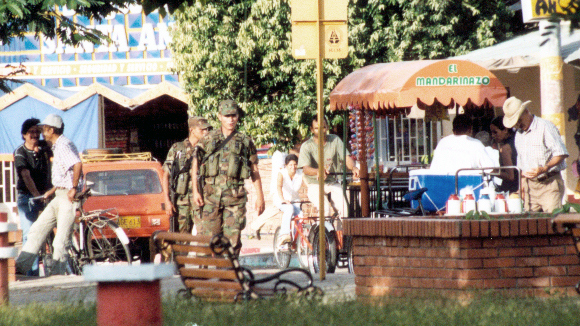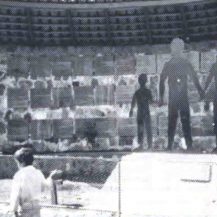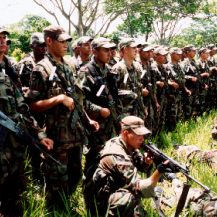Civilian “Collaborators” in Colombia’s Conflict
Though press reports often cite deaths of civilian collaborators, what qualifies as “collaboration” is rarely explored by mainstream coverage.
This text originally published: 30 March 2004

Introduction
One of the better known and most tragic facts about the Colombian civil war is that the majority of its victims are civilians. In the standard Associated Press tag-line that ends almost every piece the wire service files on Colombia, “At least 3,500 people, mostly civilians, die in the fighting every year.” Perhaps unintentionally, this phrase casts the civilian deaths in a manner that implies they occur in combat, in the crossfire of the conflict between armed groups. But what is lesser known about this aspect of Colombia’s war is the way in which so many of these civilian deaths are cast by the various armed factions—both legal and illegal—as the justifiable elimination of “collaborators” and “sympathizers” of the enemy. Though such phrases are frequently cited in press reports as the reason for civilian deaths, the parameters of what qualifies as “collaboration” are left almost utterly unexplored by mainstream coverage. Although acute observers of the war may find such topics pedestrian, defining collaboration and exploring the armed groups’ use of the concept to justify their actions is a crucial aspect of the conflict to comprehend.
Under international law, civilians are considered non-combatants unless they partake in activities that seek to physically harm combatants or their war materiel. It is important to understand that while many civilians may harbor sympathies for one side or another in the conflict, few civilians overtly assist or harass the armed groups in any substantive way. The majority of Colombia’s civilians are caught in a situation where they must be cautious at all turns not to display allegiance or aversion to the armed group(s) that hold(s) sway in the region where they live and work.
Despite their best efforts to avoid involvement, thousands of civilians are murdered by the armed groups—and thousands more are intimidated to the point where they flee their homes and become internally displaced persons or refugees—for simply going about their daily activities. This report attempts to explain some of the ways in which civilians are cast as collaborators, and in so doing, to shed light on the ongoing human tragedy in Colombia.
Colombia’s Shifting Front Lines
To begin understanding the difficulties Colombian civilians face in avoiding the label “sympathizer” or “collaborator,” one must first call to mind some simple facts about the nature of the Colombian civil war’s geography. Many people imagine warfare in terms of blue and red blocs and lines on a map, with clear-cut fronts that move with the advance of a successful army and the retreat of a vanquished one. It’s an image of war fomented by myriad sources, from historical knowledge of semi-permanent trench warfare lines in World War I to today’s television news coverage with military analysts and anchors tracking progress with oversized maps and slick computer graphics, and from pop culture cues like World War II films to board games like Risk. Though this oversimplified view still loosely applies to conventional warfare—such as the invasion phases of the two U.S.-led campaigns in Iraq—it breaks down in regions where guerrilla warfare has taken root.
In Colombia’s war of insurgency and counterinsurgency, there are no clear-cut front lines, no fixed positions. From 1999 to 2002, when President Andrés Pastrana ceded the so-called zona de despeje to the largest guerrilla group, the Revolutionary Armed Forces of Colombia (FARC), the press coverage that focused on the peace talks in the Switzerland-sized, rebel-controlled zone went some way to creating the illusion that there was a clearly-definable front line in Colombia’s war, that the FARC was in the zone and that the state forces and paramilitaries were outside it. But this view was erroneous on multiple levels. Before, during, and after the zona de despeje, the FARC had fronts throughout the country; the zone was merely a fraction of the overall territory effectively under FARC control.
At the same time, the second largest guerrilla group, the National Liberation Army (ELN), also continued its operations in a number of regions scattered across northern and southwestern Colombia. Simultaneously, the right-wing paramilitary United Self-Defense Forces of Colombia (AUC) confronted both of these guerrilla groups in many parts of the country. Meanwhile, the state’s military and police forces targeted the guerrilla groups everywhere—up to the edges of the FARC zone—and occasionally went after the paramilitaries as well, although the army and AUC were frequent allies in counterinsurgency. Smaller armed groups and militias also vied for influence in various regions of Colombia. With the collapse of the peace talks in February 2002, the FARC zone, too, became contested ground.
Across Colombia, cities, towns and countryside have been carved into very localized, often fluid spheres of influence of one armed group or another. The conflict—as well as accusations of civilian collaboration with armed groups and the subsequent slaughter of civilians by opposing armed groups—flares up when two or more groups come in contact in a given area, or when land changes hands from one side to another. Colombia’s civilians are frequently ensnared by these changes in the conflict’s often invisible “front lines.” Civilians have few choices when such shifts occur: They can remain where they live and accept the rule of the new group, and the potential for violent purges that comes with the new regime; or attempt to flee to an area where another group, perhaps one under which they are more accustomed to living, holds sway. This choice is rarely made freely: most of Colombia’s 2.2 million internally displaced have left their homes and belongings under fear of reprisal by armed groups for perceived collaboration with the armed faction that once reigned over them.
In contested cities and towns, “front lines” often exist block by block. While the state forces are obligated to wear uniforms in public—excepting instances of collusion by members of the armed forces with the paramilitaries—only in areas dominated by one illegal armed group will members of the AUC, FARC or ELN openly wear their uniforms; more often than not, members of these groups wear civilian clothes to try to blend in with the local population. While a trained eye can sometimes differentiate between non-uniformed members of the armed groups, one isn’t always certain who is who. In areas where one group has established control, the local members of that group, while dressing as civilians, do become increasingly apparent simply because their activities do not conform to the norms of civilian life—like holding down a job—and because their authority in civil affairs becomes unquestionable. Complicating matters further is the fact that some civilians—albeit a tiny minority—do actively collaborate as committed informers or partisans for the armed groups, while not going as far as bearing arms for the militants and thus not forfeiting their non-combatant status.
For the bulk of the civilian population, who seek to remain neutral in the conflict, daily life presents ample opportunities to be accused by the ever-observant armed groups of having collaborated with their opposition. While the state forces frequently control the centers of larger towns and cities, where municipal government buildings are located, the state’s authority evaporates in the poorer outlying neighborhoods, where guerrilla or paramilitary forces—or worse, both—reign. In the most extreme cases, in cities like Barrancabermeja and Medellín, the AUC has locked horns with the ELN and the FARC on a block-by-block basis in sprawling working class neighborhoods (see The Embattled Streets of Barranca and The Occupied Territories of Medellín). There, “part-time” members of the illegal armed groups form urban militias that fight alongside “full-time” combatants in vicious turf wars not unlike the gang warfare of larger U.S. cities. These groups have become the de facto authorities in neighborhoods where state forces can at best muster police sweeps or temporary army incursions to hunt down suspected militia leaders.
In Colombia’s medium-sized towns, the same themes play themselves out on a smaller scale. The current administration of President Alvaro Uribe has made retaking the medium-sized towns of once guerrilla-dominated departments like Arauca and Caquetá a centerpiece of its “democratic security” policies (see Araucan Nightmare: Life and Death in Tame and (Un)Democratic (In)Security in Caquetá). This aggressive strategy has succeeded in knocking the guerrillas out of towns they once fully controlled, but has fanned the flames of the conflict because the paramilitaries have frequently moved into these towns, arriving as a spearhead for the army at times, or more often in its wake to fill the void beyond the state’s reach.
In some towns, like Saravena and Tame in the Arauca department, the guerrillas are not so easily expelled and cling to outlying neighborhoods even as the army and the paramilitaries take charge of other sections of town. This creates ambiguities as to who is in authority, generating additional opportunities for civilians to fall prey to accusations of collaboration with one side or another (see Informers for a Day and Araucan Nightmare). Furthermore, because most medium-sized towns’ economies are intrinsically tied to the rural sectors that surround them, the guerrillas can continue to exercise influence on the populations of the retaken towns by controlling the roads that lead into and out of the towns.
In the countryside, where so many Colombians live and work, the situation can be every bit as complicated as that in the towns and cities. Some rural regions have been under the control of the state or one or another guerrilla group for decades, resulting in a relative stability. The FARC and the Colombian government—and for that matter the ELN and the AUC—use the coercive power of fear to maintain order in their territory, but do not browbeat their subjects on a daily basis, as doing so would only undermine the economic purpose of controlling the territory in the first place. This is not to say that these groups do not commit atrocities or violate the human rights of some of the civilians under their control—which all of them do to varying degrees—but rather to draw attention to the fact that the violence truly explodes when the authority of one of these regimes is challenged by the arrival of another would-be ruler.
Colombia’s rural economy is oriented toward bringing produce from small- and medium-sized farms deep in the countryside to market towns near the main roads that connect to regional capitals. Value-added processing of raw agricultural goods usually occurs in the medium-sized towns and larger cities. This means that campesinos must harvest their crops and collect their livestock, then transport their goods from the countryside toward the market towns, and possibly onward to the larger cities. In so doing, the campesino may cross multiple “fronts” of the conflict, and pass through checkpoints of various armed groups just to bring part of his or her harvest to sell at market. The very nature of this economy, which requires the movement of goods across enemy lines, presents openings for accusations of collaboration with multiple sides: What did you do in town? Who did you talk to? Were their guerrilla checkpoints on the road? Did you tell the army we had a checkpoint on the road? Do you sell produce to the paramilitaries? Do you sell produce to the guerrillas? Of course, the real question is, does the campesino have a choice?
All sides in Colombia’s conflict have committed and continue to commit human rights abuses, but they do so the vast majority of the time when vying to unseat the current authorities in a given place. Killings and atrocities are used by all the armed groups as a sort of perverse language, a manner in which to communicate dissatisfaction with the perceived political leanings of civilians, who are labeled as collaborationist or sympathetic merely as a pretense to “justify” their removal or slaughter. Because in recent years Colombia’s war has been predominantly one waged for territorial control of the country’s vast rural resources and the wealth that comes from them—from licit and illicit agricultural cultivation and ranching lands to the drive to exploit subsoil resources like petroleum, minerals, and gems—the countryside has frequently been the location of gross violations of human rights. Guerrilla domination of much of the rural sector—especially the remote frontier lands of Colombia’s south and southeast—has been increasingly challenged by the state forces and by the AUC.
What “Counts” As Collaboration in Colombia?
Colombian civilians face an almost impossible task if they are to avoid the perception that they are collaborators or sympathizers with the armed groups that happen to control the neighborhood or village where they live, work, shop, study and/or worship. One misstep or unguarded statement can lead a civilian to be accused of collaboration with an armed group. And in the harried climate of country-wide counterinsurgency, the armed groups prefer the simple “justice” of summary executions of suspected collaborators over the convoluted machinations of trials or the awkwardness of taking accused collaborators captive. An assassin, dispatched day or night, ends any potential for collaboration and closes the case irrevocably, while also sending a crystal-clear message to the local population that the armed group will not tolerate such activities. It all sounds easy enough to understand and that’s where most media coverage of civilian deaths stops. If the victim is even mentioned, it is duly noted that the armed group that carried out the killing accused him or her of being a collaborator or a sympathizer. But what are these acts of collaboration? What does it take to draw the deadly attention of an armed group in Colombia?
Simply put, just about every Colombian has done something that might result in him or herself being labeled a collaborator or sympathizer by one of Colombia’s armed groups. In truth, the armed groups act with impunity and do not necessarily have any rationale behind who they choose to target; the AUC has proven itself particularly adept at show killings and massacres that victimize unwitting civilians and leave an indelible mark on the popular consciousness.
That said, on a general level there are overarching attributes that can tarnish whole sectors of the population as alleged collaborators or sympathizers in the eyes of one armed group or another. For instance, to the guerrillas, by and large any wealthy Colombian is seen as fair game for the kidnapping-for-ransom schemes that partly fund their insurgencies. Of course, as the guerrillas cast their nets in what they call “miracle fishing,” they occasionally catch people who don’t fit the traditional prerequisites for ransom, as was the case in the FARC’s February raid on a well-to-do apartment complex in Neiva in the Huila department, where the guerrillas abducted four people, one of whom was a servant they mistook for someone more affluent.
The AUC is every bit as prone—if not more so—as the FARC and ELN to look upon wide segments of the civilian population as willing conspirators for the enemy. For the AUC, all labor organizers and human rights workers are akin to guerrilla collaborators, and thus are “military” targets. The AUC are not alone in this regard: many members of the Colombian military and police forces openly express disdain for human rights and labor activists, accusing them of working for the aims of the guerrillas. Even Colombian President Alvaro Uribe has railed against human rights workers, echoing former Paraguayan dictator Alfredo Stroessner’s remark that human rights was the Trojan Horse of international communism, by taunting rights activists to “take off their masks and stop hiding their ideas behind human rights.” With wide brush strokes like these, many Colombians can swiftly be painted as collaborators. It’s no surprise then, that Colombia leads the planet in terms of kidnappings-for-ransom and murders of labor organizers.
But there are many more levels of perceived collaboration in Colombia. While the following discussion is by no means exhaustive, it does illustrate the extent to which an armed group can cast almost any civilian action as collaboration with the enemy. Human Rights Watch and other human rights groups have repeatedly documented such cases. Sadly, the following scenarios are the everyday reality in which most Colombians live.
One recurrent theme in accusations of collaboration is “guilt by association,” though in Colombia’s boundless war, most victims are never afforded a chance to prove their guilt or innocence. In this climate, if one person is accused of collaboration with an armed faction, his or her entire family is often considered suspect. This principle has frequently been applied to the entire populations of towns, especially by the state security forces in reference to towns and villages in guerrilla-dominated areas.
In a parallel manner, attendance at rallies, church-sponsored meetings and other events that articulate a certain political line is enough to get someone branded a collaborator. State authorities frequently photograph attendees at such events to compile lists of suspects, despite the fact that freedom of assembly is protected by Colombia’s Constitution. It is a perverse extension of this guilt by association principle that, just as union membership or class affiliation can “justify” targeting civilians in the eyes of Colombia’s armed actors, so too can mere attendance at civic events or openness to a political trajectory be construed as active collaboration with the armed groups that share some of those political views. In such a climate, Colombian civilians cannot realistically hope to engage in political discourse that might lead to a peaceful resolution of the conflict.
A second class of activities that frequently lead to charges of collaboration can be characterized as “the catch-22 of conflicting demands,” whereby civilians are caught between two or more armed groups and forced to make “choices” that will invariably aggravate one of the armed actors. There are countless incidents of shopkeepers in rural small towns who have sold produce or supplies to one armed group, only to be accused of collaboration with that group when a rival armed faction comes to town. In a variation on the tactic, merchants are frequently threatened by one armed faction and ordered not to sell to members of another armed group; disobeying the order will draw the ire of the group that issued the threat, while obeying it leads the boycotted group to assume the merchant is sympathetic to the other side—in this non-choice, either path the merchant opts for is tantamount to a death sentence.
The same principle is readily applied to other forms of succor, such as providing shelter or assistance to persons alleged to be members or partisans of an armed group. It’s a measure of the absurdity and the extremity of Colombia’s war that a butcher who sells a few pounds of meat to some guerrillas becomes a collaborator in the eyes of the paramilitaries, or vice versa, and that this “collaboration” is punishable by death.
A third form of alleged civilian collaboration with armed groups is “the act of informing,” or being perceived to inform, an armed group. The armed groups refer to alleged informers as sapos (toads). But what counts as “informing” in Colombia’s war zones differs greatly from the espionage-type activities that first come to mind for those accustomed to societies not torn by internal conflict. What passes for “informing” in Colombia more closely resembles civilians under informal interrogation saying what they think a given armed group wants to hear. Though it cannot be denied that some civilians actively supply information to the armed groups with which they identify, the fact is that informing is more often than not an act which ordinary Colombians feel compelled to do, often in situations involving direct contact with armed combatants. In a broad sense, informing can also include acting as a messenger for an armed group, though this, too, is often done under duress.
Colombians face many chances of being interrogated by the armed groups. Police patrol the towns, conducting sweeps of bars or rounding up people en masse for questioning. All the armed groups—legal and illegal—set up checkpoints on roads and rivers at which they inspect documents and ask questions about civilians’ intended destinations and activities. These encounters with heavily armed combatants are nerve-wracking for civilians, as many kidnappings and summary executions begin with a stop at a checkpoint. Civilians have to parse their words carefully whenever in contact with any of the armed groups so as to avoid a potential verbal slip-up that might make them appear prejudiced toward one side or another. Moreover, civilians have to be guarded about who might be listening surreptitiously when they speak in public.
The fear of resembling—or even inadvertently becoming—an informer, or simply of being overheard saying something that sounds too partisan, cannot be underemphasized in Colombia. Armed groups repeatedly cite informing as a “justification” to level accusations of collaboration, although simply supplying information does not convert a civilian into a combatant. It is precisely this fear of “informing” an armed group either directly or indirectly about anything relevant—or of one’s words getting back to an armed group—that has stifled the ability of Colombian civilians to speak freely; instead, a self-protectionist self-censorship characterizes the public speech of many civilians in Colombia’s conflict zones, reinforcing the near-monopoly on political discourse wielded by the armed groups.
Conclusion
Like the “front lines,” the line between combatants and non-combatants, and between collaboration and everyday activity, has become utterly blurred in Colombia’s war. Although this article does not consider the issue of international law and standards for the conduct of combatants in wartime, it does not seek to downplay their importance; extrajudicial killings for any of the reasons outlined above are blatant violations of both Colombian and international humanitarian law. Rather, this article has sought to frame the issue of collaboration in the on-the-ground circumstances of daily life. In Colombia’s war-weary state, the law of the gun repeatedly trumps the rule of law. While civilians have little or no recourse to real justice, all the armed groups enjoy an impunity that allows them to spin countless civilian actions as collaboration with some armed faction.
Without negating actual instances of civilian partnership with specific armed groups (such as membership in the “part-time” militias), it is crucial to understand that little or nothing that the vast majority of Colombian civilians do in their everyday lives has any significant military or strategic benefit to any of the armed groups. Most of the feeble excuses offered by Colombia’s legal and illegal armed actors to justify their killing of civilians are unacceptable on multiple levels. Above all, the armed groups’ justifications for alleging collaboration and for killing non-combatants too frequently assume that civilians can actually act of their own free will.
In the cases outlined above, the actions that can bring accusations of collaboration against a civilian are practically inevitable in the climate of nationwide insurgency and counterinsurgency. Civilians are drawn into the conflict whether they wish to be involved or not, labeled as collaborators either by association, place of residence, socioeconomic status, individual behavior, political affiliation, or all-too-human mistakes made in the heat of a stressful moment in the heart of a brutal war. When digesting the steady stream of bloody news emanating from Colombia, one must be highly skeptical of the armed groups’ justifications and denials involving displacements, kidnappings, killings and massacres.
This article originally appeared in Colombia Journal, an online journal that was published by the Information Network of the Americas (INOTA).


